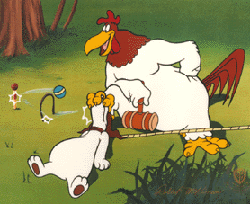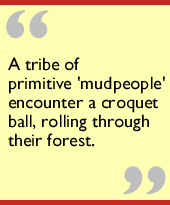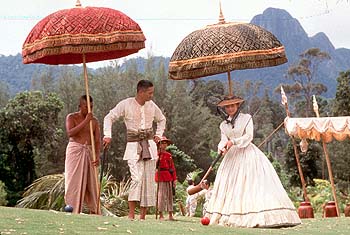

|
Back to |
| The Front Page |
| Letters & Opinion |
|
Croquet on celluloid:
It's not a pretty picture
by James Hawkins [reprinted by permission and expanded from its original publication in the English Croquet Gazette, March 2000 issue] Posted March 24, 2000 |
|
||||
While many of us are familiar with the game of croquet as documented in books and pictures, I am unaware of any similar collection based on croquet in films. Some months ago I was asked about the incidence of portrayals of the game on celluloid.
Croquet is never more than a minor supporting presence in television and movies, a facile visual metaphor for idle gentility, imperial arrogance, and classist excess. In other words, the movies precisely mirror croquet's public image as trivial, old-fashioned, and more than a little weird. If a "serious" player of the sport were anywhere to be found in films, the male would fall somewhere in the spectrum between loathsome and ridiculous, and the female...the imagination fails. Our under-appreciated sport and our playing champions cry out for honest treatment in the movies. Why shouldn't the romance of croquet be celebrated in movies like Field of Dreams and Chariots of Fire? Why shouldn't our croquet-playing leading man aspire to greatness with the passion of MacEnroe, the boldness of Tiger Woods, the courage under fire of Lou Gehrig, the sheer glamour of Joe DiMaggio? Is that too much to ask of Hollywood? Yep, way too much. But if there's an independent filmmaker out there willing to champion our cause, James Hawkins has begun the compilation of the material we must rise above

|
| Where Foghorn Leghorn is concerned, croquet is not a sport for gentlemen. |
In I'm Just Wild About Jerry (1965) Tom chases Jerry into a department store's sporting goods section, allowing Jerry "to combine table tennis with croquet." Normally, the prospect of seeing Tom hammered into the shape of a croquet hoop would be greatly enticing. However, by the 1960s, violence in Tom and Jerry had been considerably toned down. I somehow doubt this installment's place among the classics of the series.

Savages (1972) is reviewed by one website visitor as "one of the most bizarre films ever." The IMDB synopsis is worth reproducing in full: "A tribe of primitive 'mudpeople' encounter a croquet ball, rolling through their forest. Following it, they find themselves on a vast, deserted Long Island estate. Entering, they become civilized and assume the stereotypical roles and dress of people at a weekend party. There follows an allegory of upper-class behaviour. At last, they begin to devolve towards their original status, and after a battle at croquet, they disappear into the woods."
Perhaps even weirder than the plot itself is the movie's credit list. The film is an early directorial effort by the American master of English country house restraint, James Ivory. Ivory went on to direct such croquetfests as A Room with a View, Howard's End and The Remains of the Day. Savages also features noted character actor and Woody Allen favourite Sam Waterson at the bottom of the cast list, in the intriguing role of "James, the limping man."

Browsing my own memory bank, I'm struck by a few other interesting examples of croquet on film. One of croquet's most notable recent appearances is in Michael Lehmann's 1898 black comedy Heathers, in which a young Winona Ryder becomes romantically involved with the unhinged Christian Slater, who carries out the increasingly bizarre - and well-deserved - murders of a group of unpleasant croquet-playing high school cheerleaders. Seeing the film in its original release, I remember hating it for its backward-looking portrayal of pre-1869 "tight" croquet [footing striker's ball on the croquet stroke]. Perhaps on reflection this was Lehmann's intention. I anxiously await the imaginatively titled sequel Heathers 2, due for release in 2000.
On current general cinema release, a publicity still for the musicless Rodgers and Hammerstein remake Anna and the King) (which I haven't seen) shows Jodie Foster bearing a mallet in the Siamese countryside. The U.S. TV series Hart to Hart, which ran from 1979-1984, features high-living society sleuths Jonathan and Jennifer Hart. I dimly recall from my (misspent) childhood an episode in which our heroes encounter murderous goings-on among the "lawn-croquet" playing elite of California. I do not intend to resort to watching each of the 111 episodes (synopses on each of the Fan Club sites I found were sketchy) in the hope of finding the relevant scene, but somewhere out there is a recorded piece of footage of organised croquet play in the early days of North American croquet. The most unanticipated depiction of the game I've encountered comes from the 1922 F.W. Murnau vampire classic, Nosferatu, eine Symphonie des Grauens. In something like a five-second sequence, our heroine awaits her husband's return by passing the time on the croquet lawn. Not only does this show perhaps the earliest surviving depiction of the game on celluloid, but it shows that croquet's 1920's popularity had spread as far as Germany. Finally, a search on the Internet Database for the word "croquet" in recent movie credits produced only the following reference. Dutch television produced two movies in 1998 entitled Lolamoviola: Stroop and Lolamoviola: Venus . The caterer for each of these productions was an individual by the name of Marc Croquet. Croquet has since gone on to provide food for the crew of the 1999 film The Delivery.

|
| Representing 19th Century British culture at its height, Jodi Foster shows the Siamese that despite the handicap of her hoops she can whack a croquet ball with an angled sidestroke as well as any man in the 1999 release Anna and the King. |
After publication of my research in the Gazette, bibliographer David Drazin sent me a list of his film sources, which includes such gems of the Class Divide as the cringing 1998 Ralph Fiennes comedy-Englishman-in-a-hat movie The Avengers. The film has among its antecedents the extensive, undistinguished and long-dead sub-genre known collectively as "Red London Bus" movies, which in turn inspired and were inspired by the 1960s TV series of The Avengers. Unwittingly, these "Swinging London" snapshots of the Sixties have provided Hollywood with the shorthand system to portray all things English (including croquet) reduced to the role of stereotype (cf. Three Men and a Little Lady, King Ralph et al, and - with a welcome sense of irony, the Austin Powers series.
The rest of David's list includes Comin' Thro' the Rye of 1923 (no details available), Love (1927) starring a silent Greta Garbo as Anna Karenina, and the 1935 Anna Karenina in which Garbo speaks.
Croquet apparently also features in Ross McElwee's 1986 documentary Sherman's March, which traces the Civil War aftermath across the Civil War aftermath across the U.S. Southern States. Again, I'm speculating on a movie I've not seen, but the synopsis I uncovered at IMDB hinted at a quirky, frivolous emphasis to this feature (as was the trend in other 1980's U.S. cinema documentaries).
Looking back at the portrayal of croquet on celluloid, it is indeed a grim picture. Moviemakers seem to use the game as shorthand for decadence (Heathers), 'English' whimsy (The Avengers et al), aggressive competitiveness (Foghorn Leghorn), or ineffectualness (groundkeeper Willie to Principal Skinner in The Simpsons: "Ach, ya lily-livered crooquet-pleyin' jesse").
It's only with regard to the early days of the game - the 1920s in Europe (Nosferatu), and perhaps the late 70s in the States (in Hart to Hart) - that croquet receives a matter-of-fact portrayal without the baggage of uncomfortable associations from which it now suffers.
I have a couple of nagging doubts about television screenings. Firstly, I'm positive I've seen Bart Simpson playing the game, but I don't recall when. Secondly, a recent BBC period drama showed a croquet lawn outside an English country house. I don't remember which serial it was, but I fancy it may have been (anachronistically) Middlemarch. Perhaps other readers may shed more light on such references.
Croquet World Online Magazine invites you to add to the compendium of croquet in the movies which Mr. Hawkins has started and help him answer some of the questions he raises in his article. In the spirit of the Oscars, what film do you nominate as the best croquet flick of all time? The envelope, please: Send your email to the editor at bobalman@aol.com; or to Hawkins directly at jdh@rlpc.freeserve.co.uk.